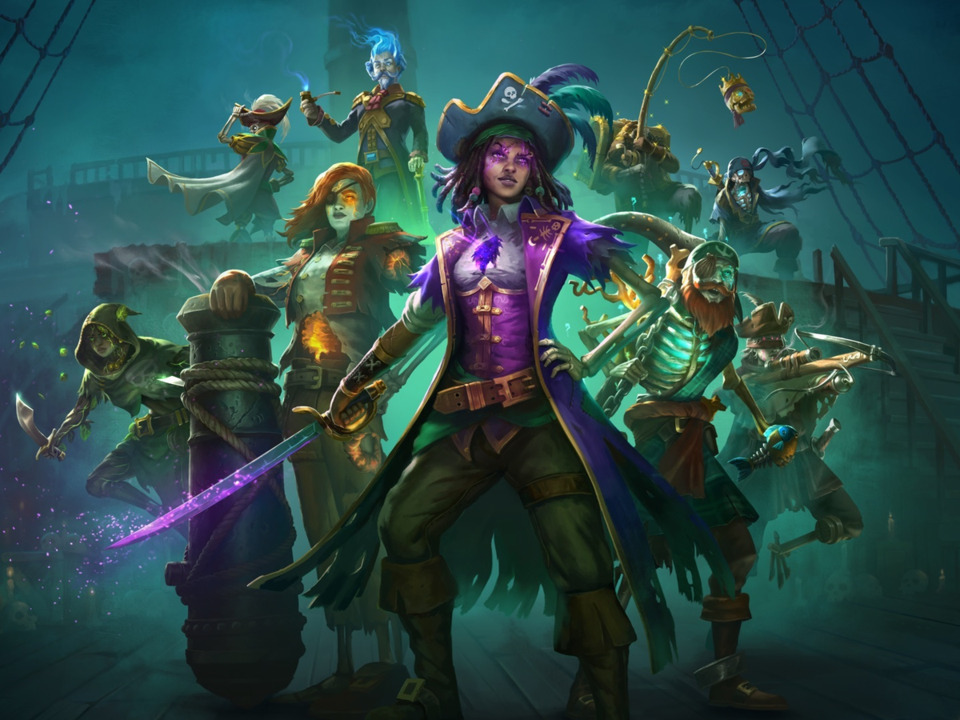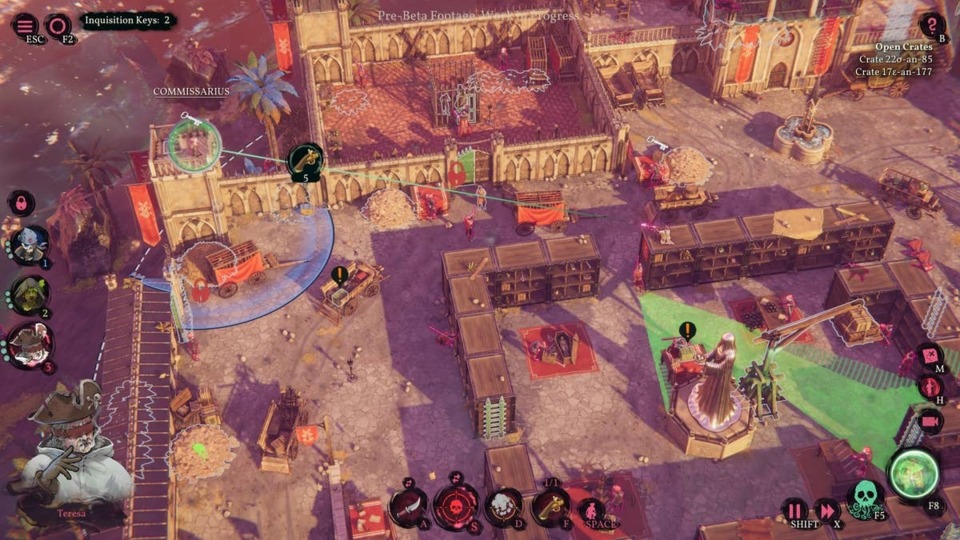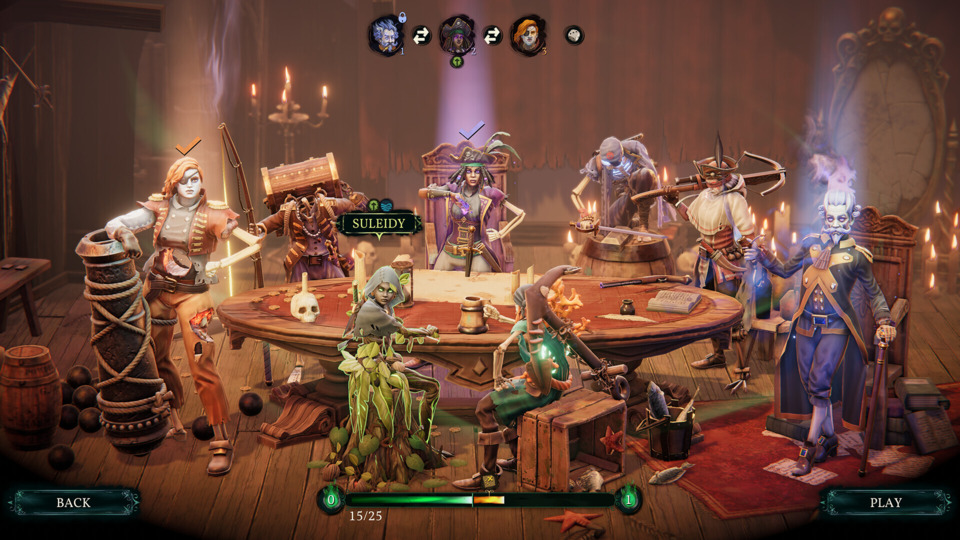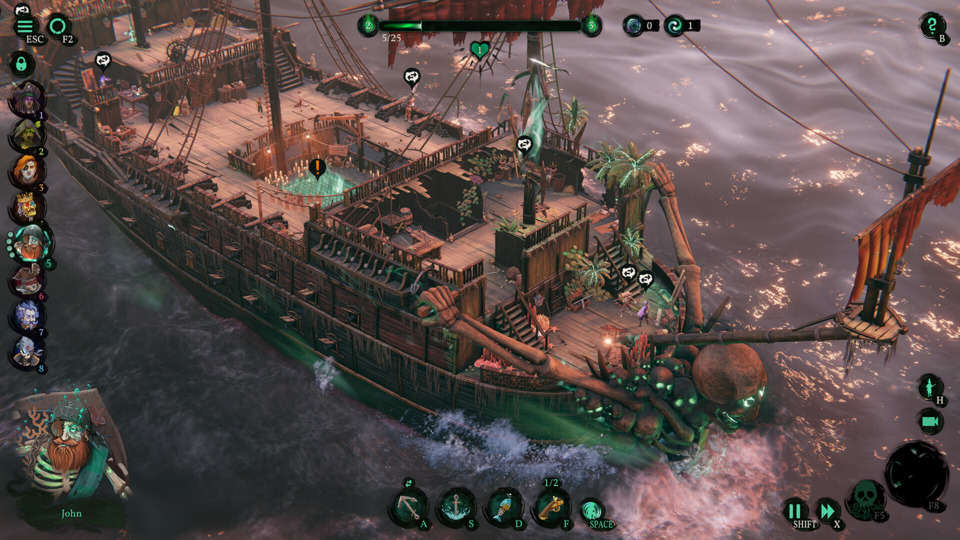Shadow Gambit: The Cursed Crew...... In Memoriam
By jeremyf 6 Comments

I don’t know what else I could have done.
The first experience I had with Mimimi Productions is with 2020’s Desperados III. It was basically on a whim. I didn’t have any experience with the isometric stealth genre it belongs to. Frankly, I wasn’t even aware there was a Desperados I or II. But giving the game a chance paid off tremendously. The expertly tuned mechanics, masterful level design, and endearing characters showed me that Mimimi wasn’t messing around. I immediately went back to Desperados’s predecessor, Shadow Tactics: Blades of the Shogun. Trading the cowboy setting for a samurai one, I was just as impressed with the studio’s first attempt at the genre. I was there for the Shadow Tactics expansion in 2021, and after that, I waited for the next big thing.
That project was finally revealed as Shadow Gambit: The Cursed Crew, applying the stealth strategy formula to ghost pirates with fantastical designs and powers. More than Zelda, Pikmin, or Spider-Man, Shadow Gambit instantly became my most anticipated release of 2023. I desperately wanted the game to be a hit. It went on my wishlist immediately. Then, I signed up to the company’s Discord server and email newsletter. I devoured the demo that was released a few months ago. Everyone I know politely put up with me as I shilled for the title. On release day, I bought the more expensive “supporter edition” because that’s exactly what I wanted to be. For the first time, Mimimi self-published its game, and I needed to be behind them every step of the way.
Shadow Gambit didn’t disappoint. It boasts the most refined and customizable iteration of stealth strategy to date. The expanded cast of characters is delightfully unique. And the visuals and music are more breathtaking than ever. As I do, I was drafting a review in my head as I played through the campaign. I debated how to measure the changes to the formula and how granular I should be when dissecting them. I wondered if I could give a fair review without coming off like a total fanboy. But, not for the first time, my slowness in putting together my thoughts allowed for something to happen that totally changed my approach.
It was during the final level of the game. I was having some difficulties with the mission and realized that even the multiple hours I had allotted wouldn’t be enough. Then, I got a ping from my phone. I saw the words I never wanted to see: Mimimi is shutting down.
I was crestfallen. For one thing, the website wasn’t actually working at the time, so I couldn’t even read the post. More to the point, I was left with the oppressive feeling of failure. I’m not so naive to think that my sole actions could have changed a company’s fate. But I had hoped that I was just one of many who would make Shadow Gambit Mimimi’s biggest success ever. I guess we don’t know that it isn’t. It launched with excellent word of mouth and “overwhelmingly positive” Steam reviews. The founders are concerned that the next game would be the one to break them. They cite family priorities, financial risk, and the threat of burnout. Instead of dealing with those stresses again, they chose to go out on top.

Is this a common thing in Germany? I’m not used to game studios ending this way. I’ve been conditioned to think that in this industry, the end goal is to get acquired by a megacorp, then slowly wither away until you’re “restructured.” Still, the way this closure was announced leaves me with more questions than they answered. For it to come less than two weeks after Shadow Gambit’s release, the decision must have been made a while ago. However, the post is written by and from the perspective of the company’s co-founders. What about the rest of the employees? When did they find out? Did they get a say in any of this? The post confirmed that everyone is getting a bonus and assistance in the job search. And while I’m grateful that my contributions can help with that, as a fan, I can’t help wondering what paths, if any, could have avoided a closure.
With all that said, we’re left with Shadow Gambit as the studio’s swan song. In the Lost Caribbean, ghostly Cursed Pirates sail the seas on ships with souls of their own. The most legendary of these ships, the Red Marley, has the power to rewind time (canonizing quick save and load) and a link to an irresistible treasure. In pursuit of the treasure, the Inquisition ensnares the Marley and destroys its captain. The ship is finally freed by aspiring pirate Afia Manicato, and the two strike a deal. Their goal is to revive the rest of the Marley’s crew and follow the captain’s clues to keep the treasure out of Inquisition hands.
If you’re familiar with Mimimi’s previous stealth games, almost everything is just the way it was. Swarms of guards stand between you and your objective, viewcones furiously searching for aberrations. Your job is to sneak by or pick them off one by one with your characters’ powers. In all of their games, every Mimimi character is a ton of fun in personality and utility. The eight members of the cursed crew are:
- Afia - Navigator. She can do a Dishonored-style blink to evade or quick kill guards and freeze foes with a magic pocket watch.
- Toya - Cook. He lures guards with his flute and can place a marker to teleport to at will.
- Teresa - Lookout. This game’s sniper class. She can also momentarily blind enemies.
- John Mercury - Shipwright. In what’s possibly the most broken ability, he can dive out of sight and pop up leagues away for a kill. He’s also got a distraction in fishy companion Sir Reginald.
- Quentin - Treasure Hunter. His fishing line pulls allies to him or activates traps from afar. Plus, he has a lure - his own golden skull.
- Pinkus - Quartermaster. He can possess guards to infiltrate their ranks undetected.
- Gaelle - Cannoness. Not the quietest option, she loads bodies into her cannon and shoots them at other soon-to-be ammunition.
- Suleidy - Ship Doctor. As a plant person, she sprouts leafy cover anywhere and sends guards on the move with spores.
The catch with this bunch of pirates is that, after choosing between Toya and Suleidy, the order in which you unlock them is up to you. It takes most of the game to have the full crew available, so you should prioritize which ones seem the most fun. Your away team for almost every mission will be three crew members chosen by you. Whatever you pick will entirely determine your approach to that level and how it plays out. With all that in mind, no two playthroughs of Shadow Gambit will be exactly the same. That makes it the most replayable Mimimi game to date. Whenever you’re in a tough spot, you might think about how a certain crew member could make things different. You’ll hopefully keep that in mind should you replay the mission.

When I heard about this system, I was conflicted. The sandbox approach is exciting. At the same time, one of my favorite aspects of Shadow Tactics and Desperados was the carefully constructed missions. In both games, you had five characters compared to Shadow Gambit’s eight. The variety came from each mission changing things up. In one level, you might have characters 1, 2, and 5, while the next level would give you 3 and 4. Some missions would have your team start split up with the goal of converging. Or, a character would be captured, and saving them would add them to the party. The scenarios were varied, but more importantly, it forced the player to adapt to the tools they had available and use them in ways they otherwise wouldn’t. From a story perspective, tons of characterization was developed with mission-specific dialogue. Finding out what came next made the campaigns exhilarating.
Inherently, the sandbox approach of Shadow Gambit strips much of that away. While you can choose your entry and exit point for each mission, your trio will always start together and likely stay together for the duration. Afia and the Red Marley will comment on what’s going on, but because no other crewmate is guaranteed to be there, they don’t have anything special to say. More importantly, you aren’t forced to change up your tactics. You’re encouraged to change your team each time, as characters not taken on a mission will generate extra XP next time they’re used, but there’s nothing stopping you from sticking with the same squad every time. I guess that’s fine if you want to play that way, but I feel a little sad for what was lost. But the moment to moment gameplay is as refined as it’s ever been, and that’s what matters in the end.
The missing characterization is still in the game, thankfully. Between missions, you’re sent back to the Marley as your hub. That’s where you can play through “crew tales.” These essentially show a day in the life of each crewmate over five parts. There’s no gameplay reward for doing these, but the cutscenes can be a blast. If you wanted to see Toya train a talking fish in assassination or gloomy Teresa forced to work with pompous Pinkus, these are for you. Once you get towards the end of the game, you unlock what are essentially loyalty missions for each crewmate. This unveils their backstories. Did you expect the goofy golden skull man to have daddy issues? I didn’t. The narrative component of these is solid, but the mission design leaves a lot to be desired. All the ones I played involved running back and forth on previously explored locations. They felt overlong, even as I consciously picked the shortest ones. Since the game forces you to finish four before unlocking the last level, it sadly comes off as padding.

So, Shadow Gambit’s focus means that not everything lives up to the bar set by Mimimi’s other games. However, some elements are better than ever. I am in love with the art style. The main color palette includes a minty green accented with purple and a dark background. It’s very pleasing to the eye and is the perfect match for this eerie setting. The crew’s designs are fantastic, too. You’ll see missing body parts, skeleton limbs, and ghostly energy in different places. Some of those are given explanations later, while others are left mysteries. Whenever a character portrait pops up, it’s a joy to scan it for little details. Environments are also highly pleasing, with wind effects that make them more alive. Seeing locations differ from day to night is its own reward beyond the gameplay variations. Last but not least, the voice cast does an amazing job bringing this multinational cast to life. Whether it’s John Mercury’s cheerful brogue, Pinkus’s haughty attitude, or Red Marley’s authoritative demands, it’s always a joy to listen to.
Spending time with these great personalities during the game gave me flashbacks of other good times with Mimimi’s characters. Mugen and Hector. Takuma and McCoy. Yuki-chan and Isabelle. These games are light on plot, but rich in character, and that’s the type of story I always prefer. Welling up all those memories only made the news of the closure hit harder. We all have weird reactions to losing our favorite entertainment. I’m usually not too hurt when a show I like is canceled because I’m used to living without it for months on end. But when you’re so embedded in the thing, it becomes a lot harder. I feel the same every time a Giant Bomb staffer says goodbye. By the end, Shadow Gambit’s story deals with the same themes. Red Marley has to learn to let go of her captain, which her power makes all the more difficult. But our favorite people live on through what they’ve left behind. In Mimimi’s case, that’s a handful of awesome games that no one else was brave enough to create. And Shadow Gambit, as replayable as it is, will tide us over for some time. I still haven’t finished the last mission. I’ll probably go back to it as soon as I post this.
It’s going to be a lot harder than it already was.
